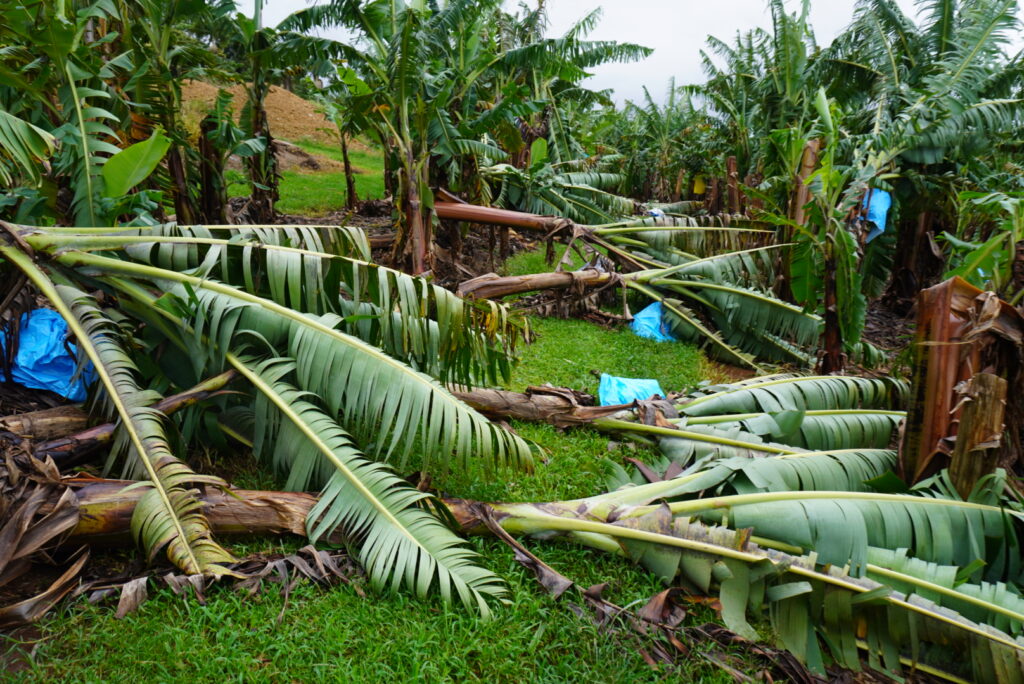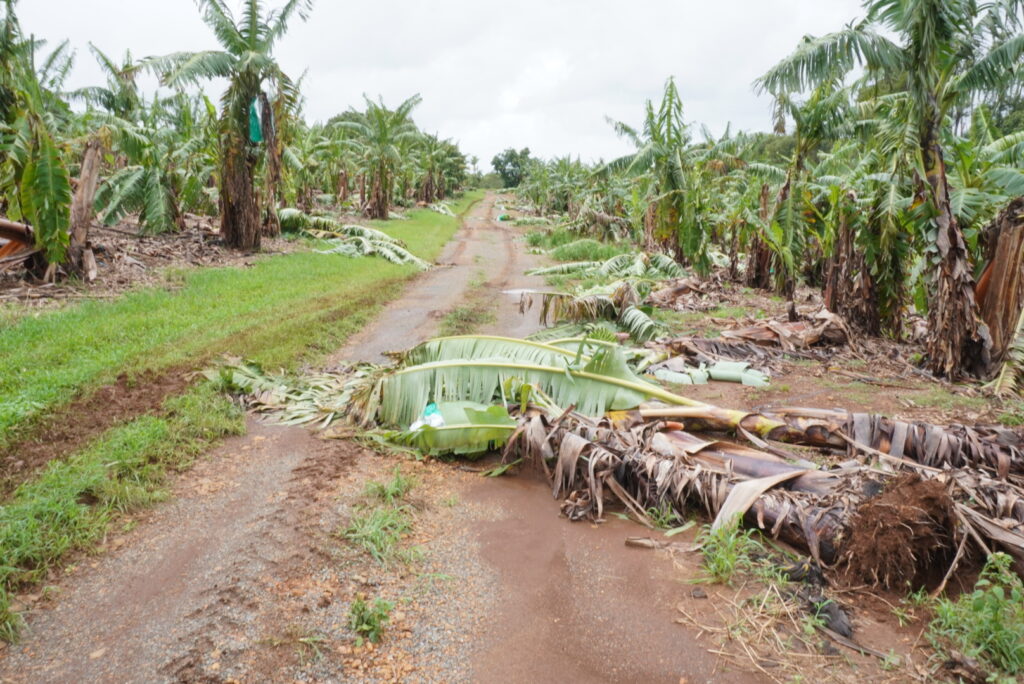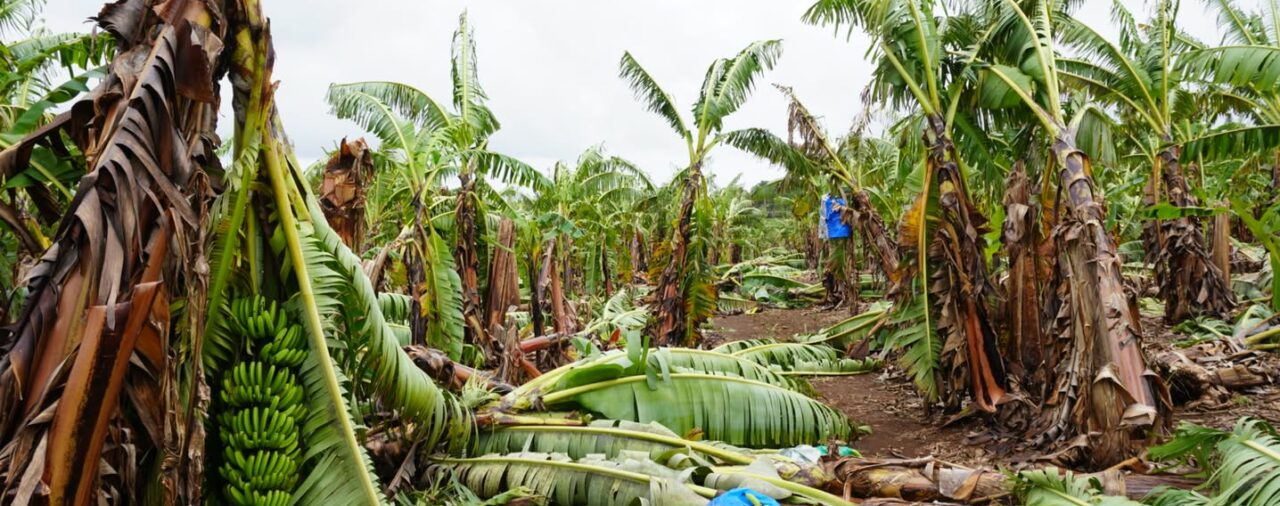*Updated April 2025*
Growers across Northern New South Wales are still counting the cost of the rain and extreme wind brought by an unusually southerntracking tropical cyclone earlier this year. While Alfred was downgraded before he made landfall, the ex-TC still proved devastating, with over 80 per cent of plantations destroyed in the worst affected areas.
Despite making every effort to protect their hillside patches, including stringing and propping, the industry is looking at a long recovery, just two years after the last severe weather event wreaked havoc.
EXTENT OF DAMAGE
The most severe damage (>50%) is concentrated in northern NSW, particularly in the Byron and Tweed regions. The most affected areas include Murwillumbah, Mullumbimby, Fernvale, Chillingham, Cudgen, and Ballina. Steven Norman, Subtropical Horticulture Development Officer, was contacted by a representative of a Tweed region grower community with limited English literacy. The representative reported widespread and severe damage to banana plantations within this group located in Tweed region.
DAMAGE REPORTS
Tweed-Byron Region
- Over 80% destruction of banana plantations in the worst-affected areas.
- Trees uprooted from the roots or snapped midtrunk.
- Loss of high-grade fruit due to fruit rubbing and bruising.
- High winds stripped remaining leaves, affecting fruit development.
- Younger plants lost leaf structure, impacting growth moving into winter.
- Uprooted stools require significant labour for replanting, delaying the next productive cycle (12 to 24 months).
- Estimated yield reductions of up to 50% for the next 12 months for those most affected.
- Increased vulnerability to future high-wind events due to weakened plant stool root structures.
Coffs Harbour & Nambucca Region
- Damage ranges between 5-25%.
- Primary damage includes uprooted trees and snapped trunks.
- High fruit loss due to bruising and stripping of protective leaves.
- Some growers forced to heavily prune, reducing expected yields by at least 50%.
- Eroded roads and blocked gullies due to heavy rainfall, impacting farm access.
LONG-TERM RISKS & CHALLENGES
- Increased Disease & Pest Risk: – Dead plant material increases the risk of banana weevil borer infestations. – Soil-borne diseases like Panama disease may spread more easily through spores and water runoff, threatening farm viability.
- Infrastructure Damage: – Fallen native vegetation (e.g., gum trees, eucalyptus, and pines) has damaged roads, banana plantations, and farm infrastructure. – Growers are using their own labour and machinery to clear debris and restore operations.
- Soil & Water Management: Heavy rainfall caused severe erosion and nutrient leaching, reducing fertiliser effectiveness and crop performance.
PREPAREDNESS EFFORTS
Growers implemented proactive measures such as tying down and propping banana plants before the cyclone. Some growers employed full-time workers for a week to secure their crops, significantly reducing overall losses. This effort should be recognised and compensated as part of disaster recovery assistance.
DISASTER RELIEF
At the time of writing, growers in disaster-declared areas have access to Concessional Loans up to $130,000. Ex-TC Alfred is a ‘Category B’ weather event, which the NSW Government states is for serious, but generally localised natural disasters. The next category – ‘category C‘ – includes grants for those affected and is “usually considered once the impacts of the disaster on affected communities have been assessed.” Category C assistance is requested from the states and requires agreement from the Prime Minister.
As one banana grower noted at a TC-Alfred information session, the grants that were available in 2022 were invaluable in starting to future-proof their properties. “The money spent on sealing roads has essentially saved those same roads this time round,” he said. While the bitumen is testament to the importance of these grants, it hasn’t saved the tonnes of fruit that has been – and will continue to be – impacted by the extreme winds brought by ex-TC Alfred. Some farms will take a year or more to properly recover, and the path to getting back up and running will be much tougher without assistance.
“We’re not big growers,” the Northern NSW grower said. “The banana industry here is already on a knife’s edge in many ways. These grants mean we don’t have to dip into our own pockets, when there’s not a lot there to start with.”
Please keep an eye out for any updates regarding disaster relief: www.raa.nsw.gov.au/disasterassistance/declarations
Other resources that may be useful:




